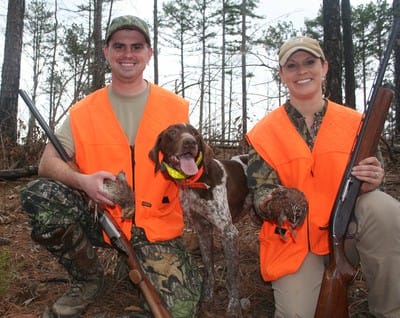
A German shorthair pointer worked the wind with skill. She would run perpendicular to the breeze for 75 yards or so, head high and olfactory senses at play, and then move forward into the wind and repeat the performance in the opposite direction from which she had just come. It was art—a symphony, a grand display of instinct and training. On the third or fourth pass, she skidded to a halt, locked tightly into the most graceful pose one could want.
“Point,” the hunt master shouted.
Two of us stepped from the buggy that was hauling four hunters and extra dogs and carefully extracted unloaded shotguns from the rack. Ordinarily, I use a Remington 870 Wingmaster in .410 bore for quail, but this day I had along another Remington—a 332 over/under shotgun in 12-gauge. The 12 is a bit much for quail, but this shotgun, no longer in production, is a classic. When it is in the crook of my arm, the moment is filled with nostalgia, romance. I hear Nash Buckingham whisper; I see tweed jackets and wool pants.

As we approached the shorthair, she was trembling with excitement. I can’t speak for my fellow hunter at that moment, but my heart rate increased and my attention was focused fully on what was about to happen. Dr. Ed Carruth, owner of Millbrook Plantation spoke softly to Daisy, an English spaniel that was trained as a flush dog. She sailed from her perch in front of the buggy and worked cautiously toward the birds. That spell cast by the point, that animated moment of suspended time, was broken by a flurry of wings as the little spaniel put the quail to flight.
Four shotgun blasts disturbed a quiet morning. A trio of bobwhites tumbled from the covey of perhaps a dozen. Realizing that two of these three birds fell to my shooting, which is often inept, I looked at the Remington and smiled. It fit me well; it performed perfectly.
By the time we headed back to the lodge for lunch, we had put up 14 coveys of spunky birds. The final tally was 37 quail brought to bag. It had been a good morning.
In countless areas across the country, quail hunting has fallen victim to diminished populations of birds and decreased access to suitable habitat. Gone, for the most part, are those days when every country lad had quail in abundance on family and/or neighboring lands and was free to hunt them. I grew up with such an idyllic situation, but by the late 1960s that was already fading. A great deal of today’s quail hunting is relegated to shooting preserves. When done right, this approach is not nearly as dismal as it may sound. There are several key ingredients to making a shooting preserve truly successful and fully enjoyable. One tactic is early release.
Early release is as the name implies, but it is far more complex than simply placing birds in the field hours or even days before the hunt. It entails establishing coveys of flight-conditioned birds around feeding stations with call-back boxes and predator protection. This is often done a month or more before the actual hunting begins for the season. Feeding stations provide food for the birds as they acclimate to the natural surroundings and adapt to fending for themselves. Call-back boxes keep the quail oriented to a specific area. And predator protection structures, often just stacked brush under which quail can scoot to avoid raptors, aid in survival. These practices are essential to success.
But success doesn’t stop there. Proper land and timber management are required. This provides a habitat that affords an ongoing food supply of both planted and natural foods and offers an ideal setting in which the quail can move about, rest, and even raise their young. It basically is a created condition that translates into what wild quail hunting was in years past, and the birds become those wild beings that most hunters seek. It is expensive and labor intensive, certainly not some short-term proposition, but the results are most positive.
Quail hunting is not what it once was in many areas of the country. Changes in land use and access have impacted it significantly—and tragically in some cases. But systems such as early release, when practiced by dedicated quail enthusiasts, reverse the downward trend. Such approaches put quail hunting back to where it once was, back to where it should be. And it is simply too good to miss.
Contact:
Millbrook Plantation; 601-659-9922.
Remington Arms; www.remington.com.







